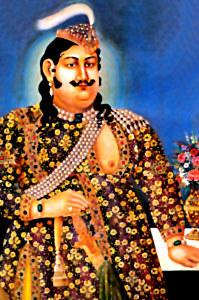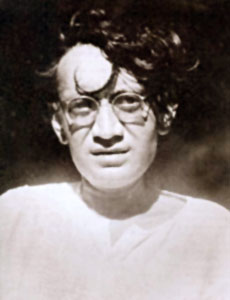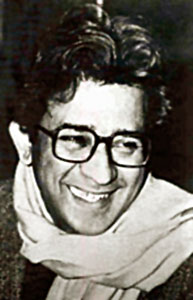 Urdu is one of the few languages spoken across India and also Pakistan without a clearly demarcated regional home. It developed alongside modern Hindi, with which it shares a substantial vocabulary. Although it borrows more from Persian and Arabic whereas Hindi draws from Sanskrit, and they have separate scripts, these differences are academic and facile because the colloquial overlap is considerable. The folk form of Nautanki, for instance, uses a mixed Hindustani idiom of Hindi and Urdu. This is understood by speakers of both tongues.
Urdu is one of the few languages spoken across India and also Pakistan without a clearly demarcated regional home. It developed alongside modern Hindi, with which it shares a substantial vocabulary. Although it borrows more from Persian and Arabic whereas Hindi draws from Sanskrit, and they have separate scripts, these differences are academic and facile because the colloquial overlap is considerable. The folk form of Nautanki, for instance, uses a mixed Hindustani idiom of Hindi and Urdu. This is understood by speakers of both tongues.
Strictly `Urdu` theatre begins with a number of musical compositions in the mid-nineteenth century. The earliest one was called rahas. These were written, directed, and designed by the Avadh prince, Wajid Ali Shah, in Lucknow. Glowing descriptions of this royal entertainment inspired Amanat to compose his famous musical Indarsabha i.e. `Indra`s Court` in 1853. In later days it staged in an open public space and, probably, also in the palace compound at Lucknow. It was an immediate and immense success both in performance and in print. With Indarsabha, the nascent drama in the Urdu language came out of the exclusive precincts of the court and made its debut on the public stage. Such was its popular impact that it inspired dozens of imitations elsewhere, causing a veritable tradition of sabba plays to emerge. Amanat`s work continued to be performed by commercial companies well into the twentieth century.
A more evolved phase started with the rise of Parsi theatre in Bombay. From 1854, these groups usually concluded their main Gujarati plays with farcical Urdu afterpieces. In terms of the quantum written and produced, Parsi theatre`s heyday was the most productive period in the history of Urdu drama. Soon after the emergence of the first professional companies, the commercial potential of the language was recognized and the managers developed their Urdu activities. In the beginning, they made do with scripts written or translated from Gujarati by local Urdu speakers, of whom Raunaq and Aram are best known. Raunaq and Aram composed many plays and `operas` for the Victoria and Alfred troupes. Later, with growing possibilities for touring, the owners started recruiting `genuine` Urdu writers mainly from the United Provinces and Delhi, like Murad and Hubab.
As scriptwriting became a lucrative career option, many who could write and versify in Urdu took to drama. A few stayed on in north India, like Hafiz Abdullah and Nazir Akbarabadi, to become popular there. Although a majority of these new playwrights were mechanical run-of-the-mill wordsmiths. Some of them such as Talib, Ahsan, and Hashr, had genuine talent and creativity. Hashr, in particular, displayed outstanding merit. His work had a freshness and originality of imagination rare in the theatre of the time. He was a serious author. He tried to raise the literary and intellectual standard of drama and introduced contemporary social and moral concerns.
These major playwrights, employed full-time by the important companies. These were invented the distinct style recognizable as the standard recipe of Parsi theatre. They were often well versed in several languages and familiar with the forms and traditions of Hindustani classical music. The directors, with whom they worked closely, were college-educated and had a degree of familiarity with European literature. Under their influence, Urdu drama became technically better constructed and acquired a significantly greater sense of the theatrical than the rahas and sabha compositions. The plays were mostly based on fantastic stories of erotic love and heroic adventure. These were derived from diverse traditional sources such as Indian folklore, Hindu mythology, popular history, Firdausi`s Shahnama, and the Arabian Nights. This preoccupation with old, unrealistic tales held the Parsi stage until its very end. However, at the behest of the managers and with their active collaboration, a number of free and highly melodramatic Urdu adaptations of Shakespeare were made around the turn of the century. Afterwards, as nationalist sentiment against colonial domination intensified, original drama of religious, social, and sometimes patriotic import also appeared.
 The musical tradition continued to dominate. No opportunity was ever missed of introducing songs, dances, or rhymed verse. The Shakespearean adaptations also followed the standard commercial strategies. Even distinguished writers like Ahsan and Hashr were obliged to interpolate not only comic subplots and the mandatory happy ending, but an abundance of songs and dances into the plots derived from the Bard. Possibly the north Indian Urdu poets were hired as resident authors. They brought over this tradition. This is because of the reason the kind of plays they wrote is significantly different from the kind that Parsi theatre presented in its early years. For example, in Aram`s translations of Edulji Khorey`s Gujarati originals, songs and verses are woven into the fabric of the plot and seldom function as autonomous musical interludes. They usually do in the drama of subsequent decades. Another stylistic element that the Urdu writers contributed was nasr-e-muquaffa i.e. rhymed prose. The lineage goes back to early dastan or narrative literature. Although it made the dialogue stilted and artificial, it did enhance the aural quality and immediate impact in performance.
The musical tradition continued to dominate. No opportunity was ever missed of introducing songs, dances, or rhymed verse. The Shakespearean adaptations also followed the standard commercial strategies. Even distinguished writers like Ahsan and Hashr were obliged to interpolate not only comic subplots and the mandatory happy ending, but an abundance of songs and dances into the plots derived from the Bard. Possibly the north Indian Urdu poets were hired as resident authors. They brought over this tradition. This is because of the reason the kind of plays they wrote is significantly different from the kind that Parsi theatre presented in its early years. For example, in Aram`s translations of Edulji Khorey`s Gujarati originals, songs and verses are woven into the fabric of the plot and seldom function as autonomous musical interludes. They usually do in the drama of subsequent decades. Another stylistic element that the Urdu writers contributed was nasr-e-muquaffa i.e. rhymed prose. The lineage goes back to early dastan or narrative literature. Although it made the dialogue stilted and artificial, it did enhance the aural quality and immediate impact in performance.
In contrast, post-Parsi Urdu drama distinguishes itself by its serious social and moral concern, and realism of form and style. Theatre was no longer merely a source of recreation but also of meaningful experience. New authors wrote plays that, directly or parabolically, dealt with contemporary reality and problems. They tended to use colloquial speech and eschewed the practice of arbitrarily superimposing songs and dances. However, there was no commercial Urdu stage any longer. Same happened with the professional Urdu play writers. As in several other Indian languages, it came virtually to a halt. Only the actor-manager Master Fida Hussain kept his company alive till 1968, in Calcutta. Normal growth of Urdu theatre was also disrupted by the rise of linguistic communalism, which wrongly identified Urdu and Hindi with Islam and Hinduism respectively. It causes Urdu`s popular base to shrink drastically during the middle decades of the twentieth century.
In the absence of a durable and financially viable Urdu stage, plays were written only sporadically. They were written by litterateurs who in most cases were not primarily dramatists. Their composing of texts was separated from the theatre and the results were often unstageable. It produces a literary drama of more interest in reading than in performance. Although this tradition goes back to the turn of the century, it became a major phenomenon only after the death of commercial theatre. Many eminent writers such as Imtiaz Ali Taj, Saadat Hasan Manto, Ali Sardar Jafri, Majnun Gorakhpuri, Upendra Nath Ashk, Rajinder Singh Bedi, Abid Husain, Mohammed Mujib, Zahida Zaidi, Mohammad Hasan, Rifat Sarosh, etc. contributed to this relatively large and varied corpus of literature.
Urdu drama re-established its connection with practical staging during the 1940s with Prithvi Theatres` productions. These works, by Lai Chand Bismil, Inder Raj Anand, and Prithviraj Kapoor himself, were written in Hindustani. Prithvi introduced eminent actresses to the Urdu stage, like the sisters Zohra Segal and Uzra Butt. Certain chapters of the Indian Peoples Theatre Association (IPTA) also performed Urdu plays and adaptations by Khwaja Ahmad Abbas, Sardar Jafri, Ismat Chughtai, Ashk, and Habib Tanvir. Prithvi and IPTA advanced the cause of socially committed Urdu theatre. During the 1950s, the work of Qudsia Zaidi and her Hindustani Theatre further intensified the element of modernity by presenting serious and skilful adaptations of major European dramatists. Stage worthy translations from Indian and foreign languages by famous Urdu writers such as Sajjad Zaheer and Majnun Gorakhpuri continued in subsequent decades.
 For a period Urdu theatre also witnessed a revival of the musical form, mainly associated with Sheila Bhatia and her Delhi Art Theatre. Between 1969 and 1990, she wrote or commissioned scripts dramatizing celebrated Urdu poets and verse, and directed them emphasizing musical rendering of poems. Her productions of Ghalib kaun hai i.e. `Who Is Ghalib?` in 1969, by S. M. Mehndi, Dardayega dabe paon i.e. `Pain Will Creep in Quietly` in 1979, Yeh ishq nahin asan i.e. `This Love Isn`t Easy` in 1980, and Amir Khusro in 1987 proved highly popular with lovers of Urdu poetry. But all of these were dramatically weak.
For a period Urdu theatre also witnessed a revival of the musical form, mainly associated with Sheila Bhatia and her Delhi Art Theatre. Between 1969 and 1990, she wrote or commissioned scripts dramatizing celebrated Urdu poets and verse, and directed them emphasizing musical rendering of poems. Her productions of Ghalib kaun hai i.e. `Who Is Ghalib?` in 1969, by S. M. Mehndi, Dardayega dabe paon i.e. `Pain Will Creep in Quietly` in 1979, Yeh ishq nahin asan i.e. `This Love Isn`t Easy` in 1980, and Amir Khusro in 1987 proved highly popular with lovers of Urdu poetry. But all of these were dramatically weak.
In this respect Tanvir`s first major play, Agra bazar i.e. `Bazaar in Agra` in 1954, theatricalized the eighteenth-century environment. In that play the poet Nazir Akbarabadi lived and wrote. This was truly significant as a contemporary musical. It combined dramatic interest and music with remarkable skill and meaningfulness. His other notable Urdu contributions were Shatranj ke mohre i.e. `Chess Pieces` in 1951. This was based on Premchand and Mere bad i.e. `After Me` in 1969, making him the main personality in Urdu theatre since Independence.
In recent years a new generation of Urdu playwrights has emerged. Still struggling to make a mark, they work with little-known amateur groups in different parts of India, including Mumbai, Pune, Hyderabad, Delhi, Patna, and Calcutta. However, they do not add up to a sustained dramatic tradition. Despite their zeal and effort, the future of Urdu theatre, linked as it is to the fate of the language, continues to be problematic. There are several reasons for this. Some can be mentioned as a narrowing of Urdu`s social base, lack of recognition, and inadequate official support for the language and its rich cultural heritage. Another is the changed social status of theatre in general, for a marginalized art form that survives largely on government subsidy, corporate sponsorship, or patronage of a small though culturally enlightened minority. These do not attract professionals.
Yet another factor that makes it difficult to speak of Urdu theatre as a distinct entity is the rise of realism itself. An important feature of this is that dramatic speech corresponds to the nature of the subject and social background of the character. This often has the effect of blurring the lines between Urdu and Hindi, a difficult distinction at all times. Apart from a few relatively minor authors and small groups dedicated to the cause of promoting Urdu drama, there are no major playwrights who write exclusively in Urdu, nor an exclusively Urdu stage. For example, the Hindi dramatist Surendra Verma used Urdu in his play on Ghalib, Qaid-e-hayat i.e. `Imprisonment of Life` in 1983. B. V. Karanth employed a Persianized form of Urdu in translating Girish Karnad`s Tughlaq because the subject demanded it. Safdar Hashmi wrote his street plays in Hindi-cum-Urdu. Habib Tanvir mostly uses a mixed naturalistic idiom in which Urdu coexists with colloquial Hindustani and Chhattisgarhi dialects. Reotisaran Sharma scripts radio and television drama in both Hindi and Urdu.




